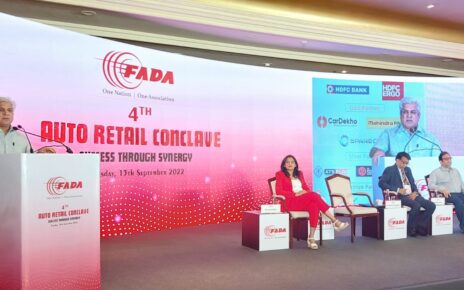When the GST Council met for its 56th session in New Delhi, few expected such a sweeping set of reforms. But the announcement of sharp tax cuts on vehicles has turned into a game-changer for India’s automotive market.
Effective September 22, 2025, GST rates on small cars, two-wheelers, and commercial vehicles have been slashed from 28% to 18%, offering immediate relief to the common man and the aspirational middle class. While electric vehicles continue to enjoy the lowest slab of 5%, mid-size and larger cars have been brought under a uniform 40% GST. The move is expected to not only lift consumer sentiment but also inject fresh energy into an auto industry that thrives on affordability and volume.
The industry has warmly welcomed the GST Council’s landmark decision, calling it a festive gift for both consumers and businesses. Automakers said the reduction of GST on small cars, two-wheelers and commercial vehicles to 18% will make mobility more affordable for first-time buyers, middle-income families, and fleet operators, while the continued 5% rate on EVs will sustain India’s shift towards clean mobility. They noted that lower taxes will not only lift consumer demand but also accelerate fleet modernisation, support sustainable practices like reduced emissions, and strengthen India’s long-term competitiveness.

Mr. Shailesh Chandra, President, SIAM, said, this timely move is set to bring renewed cheer to consumers and inject fresh momentum into the Indian Automotive sector. Making vehicles more affordable, particularly in the entry-level segment; these announcements will significantly benefit first-time buyers and middle-income families, enabling broader access to personal mobility.

Passenger Vehicles
Mr. Unsoo Kim, Managing Director, Hyundai Motor India, said, the GST overhaul will directly benefit the automotive sector. The announced reforms align seamlessly with the Government’s commitment to Viksit Bharat and the Make in India initiative, encouraging domestic manufacturing and boosting demand across both urban and rural markets. Notably, 60% of our ICE portfolio will now fall under the 18% slab rate, with the remainder at 40%.

Santosh Iyer, MD&CEO, Mercedes-Benz India, said, “Government listened to the automotive industry’s long-standing wish list of rationalizing GST rates. This GST revision is the step in right direction, is progressive and will induce the much-needed impetus by boosting consumption and bring momentum to the automotive industry which essentially remains the pulse of the Indian economy.

Commercial Vehicles
Mr. Girish Wagh, Executive Director, Tata Motors, said, this landmark reform will significantly accelerate fleet modernization, driving the adoption of safer, smarter, and greener vehicles across India. By resolving the long-standing issue of inverted duty for transporters, it unlocks greater affordability and liquidity, strengthening the entire commercial mobility ecosystem. Further, the reduction in GST on hydrogen fuel cells to 5% is a forward-looking move that reinforces India’s commitment to clean energy and zero-emission mobility. This timely intervention is a catalyst for sustainable growth in logistics and public transport, a boost to economic momentum, and a powerful enabler in India’s journey of inclusive growth and nation building.”

Mr. Shenu Agarwal, MD & CEO, Ashok Leyland, said, “The shift to a streamlined two-tier system of 5% and 18% will not only ease compliance but also bolster key sectors, uplift consumer sentiment, and reduce the financial burden on the common man. Crucially, this move will help mitigate the impact of the recently imposed US tariffs. The specific relief for the commercial vehicle industry is especially welcome. On one hand, it will spur freight traffic, and on the other, it will bring down the cost of buses and trucks, unleashing demand trajectory for commercial vehicles.”
Mr. Narinder Mittal, President & Managing Director, CNH India “These GST reforms will accelerate mechanization by making tractors, harvesters, balers and implements more affordable, while lowering overall operating costs for farmers. This empowers industry players to address labour shortages, enhance farmer’s productivity, and promote sustainable practices.
Auto Components

Auto component makers, too, hailed the uniform 18% slab on components as a historic reform that will curb the grey market, ease compliance, reduce ownership costs, and boost MSMEs. Many also pointed to structural changes such as faster refunds, correction of inverted duty structures, and policy stability as measures that will improve liquidity, ease of doing business, and encourage further investments in manufacturing, innovation, and localisation.
Ms Shradha Suri Marwah, President, ACMA, said, the rationalisation of GST to a uniform 18% across all auto components has been a long-standing recommendation of ACMA. This decisive step will curb the grey market, encourage the use of quality compliant components, ease compliance, and support MSMEs – thereby strengthening the global competitiveness and resilience of India’s USD 80.2 billion auto component industry. “We also welcome the GST Council’s approval for faster export refund claims through ICEGATE for smaller exporters, which will help clear pending shipping bills and significantly ease liquidity constraints,” she added.

According to Deepak Jain, Chairman, Lumax Group, consumers will benefit from more affordable vehicles and reliable spare parts in the aftermarket, improving both safety and ownership experience. The reforms, well timed, will also bring optimism ahead of the festive season, with demand expected to rise across entry-level passenger vehicles and two-wheelers.

Udit Sheth – Vice Chairman, Setco Automotive, said, “We see this move as a catalyst for growth in the commercial vehicle sector, and we are optimistic about the momentum it can generate for the broader economy.”
Chairman and Managing Director, ASK Automotive Limited Kuldip Singh Rathee, said, “The next-generation two-slab tax structure marks a landmark reform for the Indian economy and will help ease the lives of the common man. We particularly appreciate the measures taken for the automobile sector, especially for small cars and two-wheelers up to the 350cc segment. This will provide much-needed relief to an industry that has been struggling for the last few years.

By making vehicles more affordable, streamlining auto component taxation, and sustaining support for electric mobility, the government has laid a strong foundation for growth. For consumers, it means easier access to mobility. For the industry, it opens the road to higher volumes, modernisation, and cleaner technologies. As the festive season begins, the Indian auto sector finds itself in the fast lane once again, powered by a tax structure designed to drive both aspiration and sustainability.




